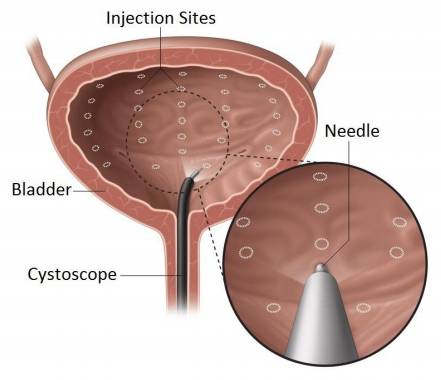Botox Injections for the treatment of an Overactive Bladder
Please note, this page is printable by selecting the normal print options on your computer.
What is Botox (Botulinum toxin)?
Botox is a muscle relaxant that is injected into the muscles of the bladder. It can relieve symptoms of overactive or irritable bladder, with/ without urge incontinence. It is recommended by NICE (National Institute for Health and Care Excellence) for women who have tried but not had any relief from other treatments, such as medication and bladder retraining.
What are the benefits of Botox injections?
Botox injections can reduce the frequency, urgency and incontinence symptoms associated an with overactive bladder.
What are the side effects or risks of Botox injections?
• Urinary Retention/ Temporary inability to pass urine. Some women may need to perform intermittent self-catheterisation and you will be taught how to do this prior to your procedure.
• Flu-like symptoms and fatigue.
• Blood in the urine, which should settle within 48hours.
• Risk of urinary tract infection.
If you experience any of the following symptoms, please see your GP:
• Passing urine frequently.
• Pain on passing urine/ Cloudy urine.
• Feeling hot/ having a temperature.
How is the procedure performed?
Botox is most often injected as an outpatient procedure under local anaesthetic. A local anaesthetic gel will be applied to the urethra. A narrow telescope is then used to examine your bladder – this is called a cystoscopy. The Botox will then be injected through a special needle into areas around your bladder.
After the Procedure
You will be able to go home immediately after the procedure. Botox injections may take 7-14 days to take effect. You will be reviewed in clinic two weeks after your procedure by the Urogynaecology Nurse Specialist. The nurse will scan your bladder to check for urinary retention. If you are retaining urine you may need to undertake a period of bladder retraining using intermittent self-catheterisation. The effects of the Botox injections can last from one to three years and you can have repeat injections if the effect has been beneficial. You will need to contact the department when you feel your symptoms have returned.

References:
National Institute for Health and Clinical Excellence (NICE) Website: www.nice.org.uk
Contact Us:
Treatment Centre Reception Desk: 01908 995 452
UroGynaecology Secretary: 01908 996318
UroGynaecology Nurse Specialist: 01908 997119
Useful Contacts:
Cystitis and Overactive Bladder Foundation Website: www.cobfoundation.org
Bladder and Bowel Foundation Website: www.bladderandbowelfoundation.org
